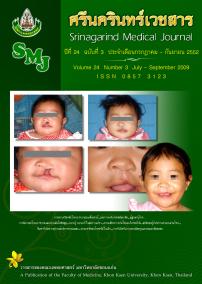ThaiScience
ThaiScience
SRINAGARIND MEDICAL JOURNAL
Volume 35, No. 04, Month JULY, Year 2020, Pages 404 - 409
Mortality and predictive factors in pediatric severe sepsis and septic shock after implementation of surviving sepsis campaign guideline in srinagarind hospital
Rattapon Uppala, Chanida Wongrat
Abstract Download PDF
Background and objective: Prompt treatment of sepsis and septic shock in pediatric patients could lead to an improved outcome. The Surviving Sepsis Campaign have been launched to guide treatments and has been followed by most contemporary centers. However, it has not been widely utilized in developing countries due to inadequate resources in multiple levels. This study aimed to investigate mortality rates and associated factors in children with severe sepsis and septic shock treated in the Pediatric Intensive Care Unit (PICU) of Srinagarind hospital, Khon Kaen university (KKU) after the implementation of the survival sepsis campaign guideline. Method: A retrospective chart review was conducted on patients aged 1 month – 15 years treated in the PICU of Srinagarind hospital for sepsis and septic shock in 2013 after the distribution of the sepsis bundle guideline to pediatric residents. The mortality rate was compared with a historical control (Patients treated with sepsis and septic shock in 2012). Results: Thirty patients, median aged 8.5 years (2 months – 14.5 years) were included. The two most common co-morbidities were hematologic malignancies (37.9%) and connective tissue disease (13%). After the implementation of the sepsis bundle guide line, the mortality rate has significantly decreased from 65.2% to 23.3% (p=0.002). Factors associated with increased mortality included the DIC (OR 10.5, 95%CI 1.06 – 103.5), central venous oxygen saturation (ScvO2) <70% (OR 16.5, 95% CI 1.0 - 250.1), and lactate level > 4 mmol/L (OR 28.3, 95% CI 2.3 - 336.0). Improved outcomes could potentially be explained by adequate initial fluid resuscitation, appropriate use of antibiotics, and earlier initiation of inotropic agents. Conclusions: Implementation of the sepsis bundle guideline in a tertiary care center in developing country lead to outcome improvement. A multicenter prospective study in a larger population could better clarify its role in developing countries
Keywords
Guideline implementation septic shock severe sepsis severe sepsis resuscitation bundle Surviving Sepsis CampaignSRINAGARIND MEDICAL JOURNAL
Published by : Faculty of Medicine, Khon Kaen University
Contributions welcome at : http://www.smj.ejnal.com/e-journal/journal/index.php
